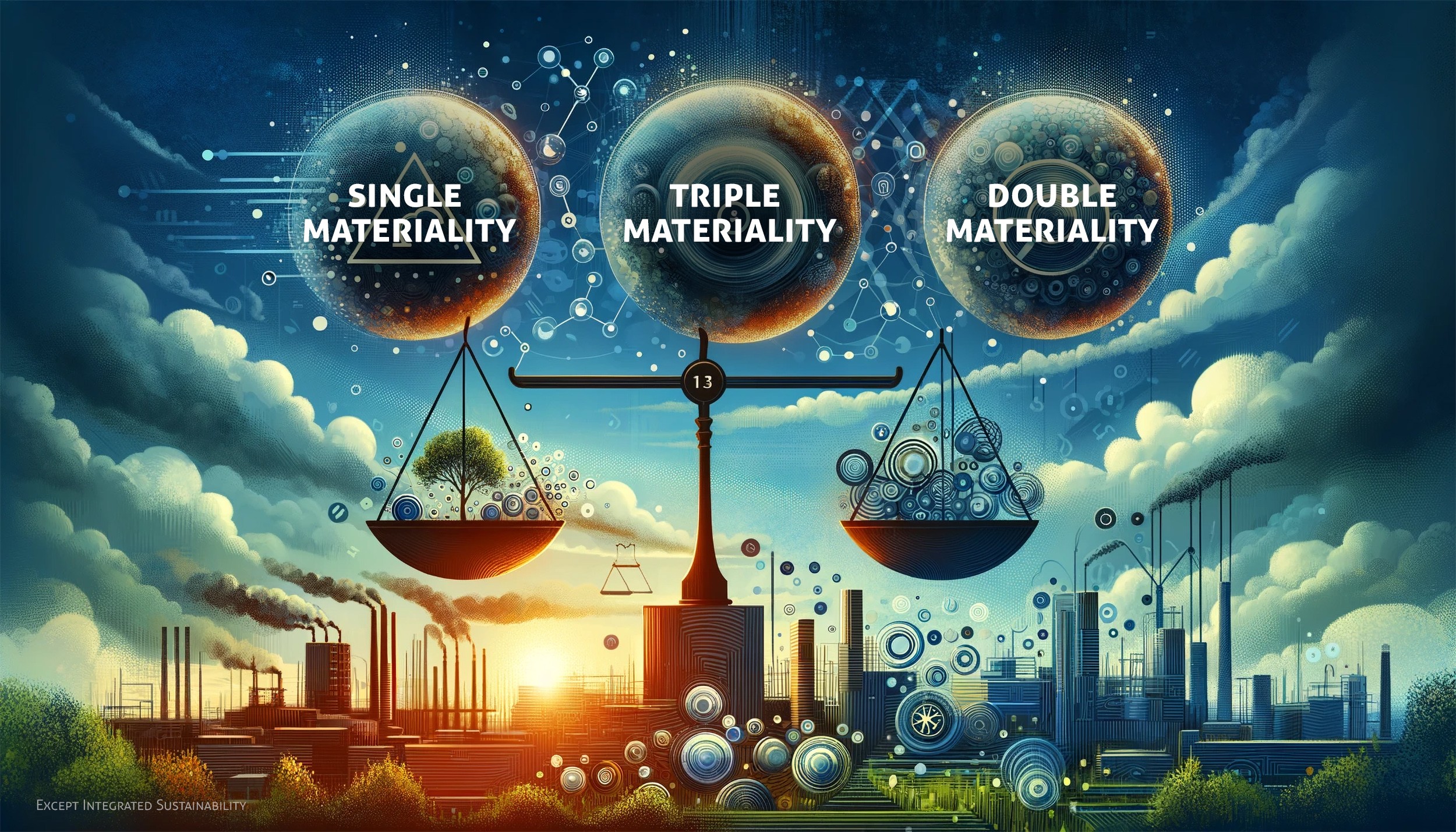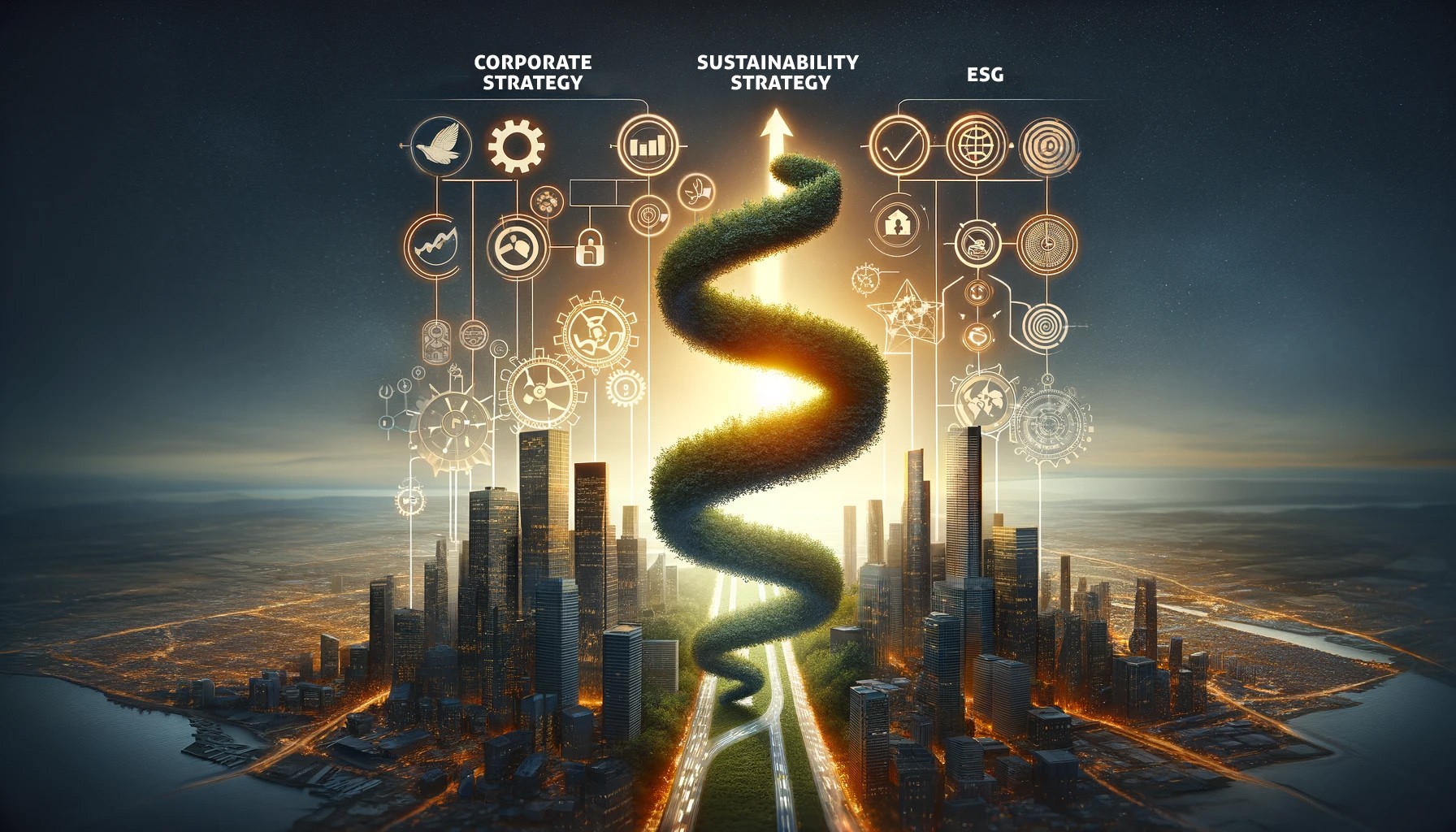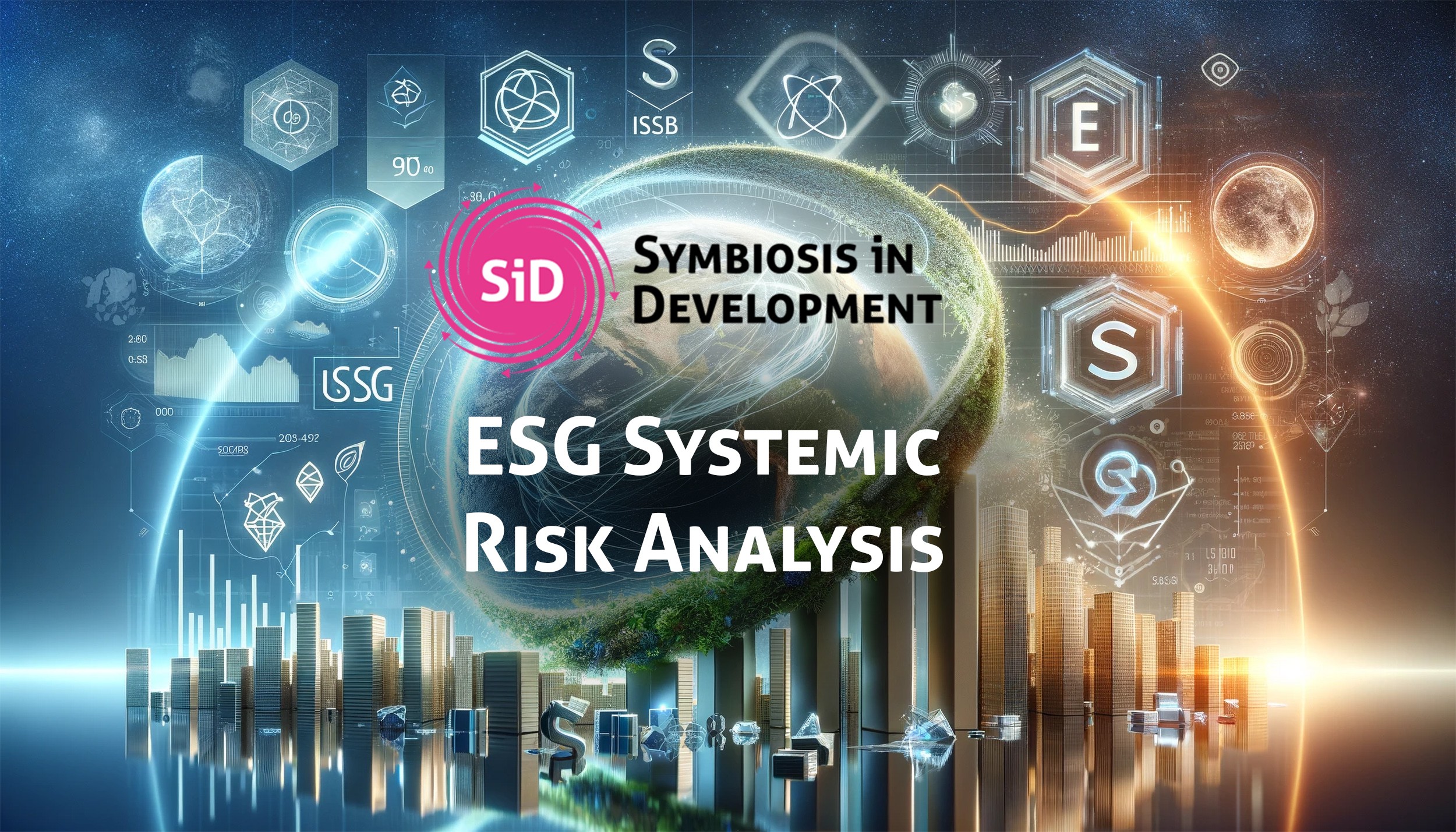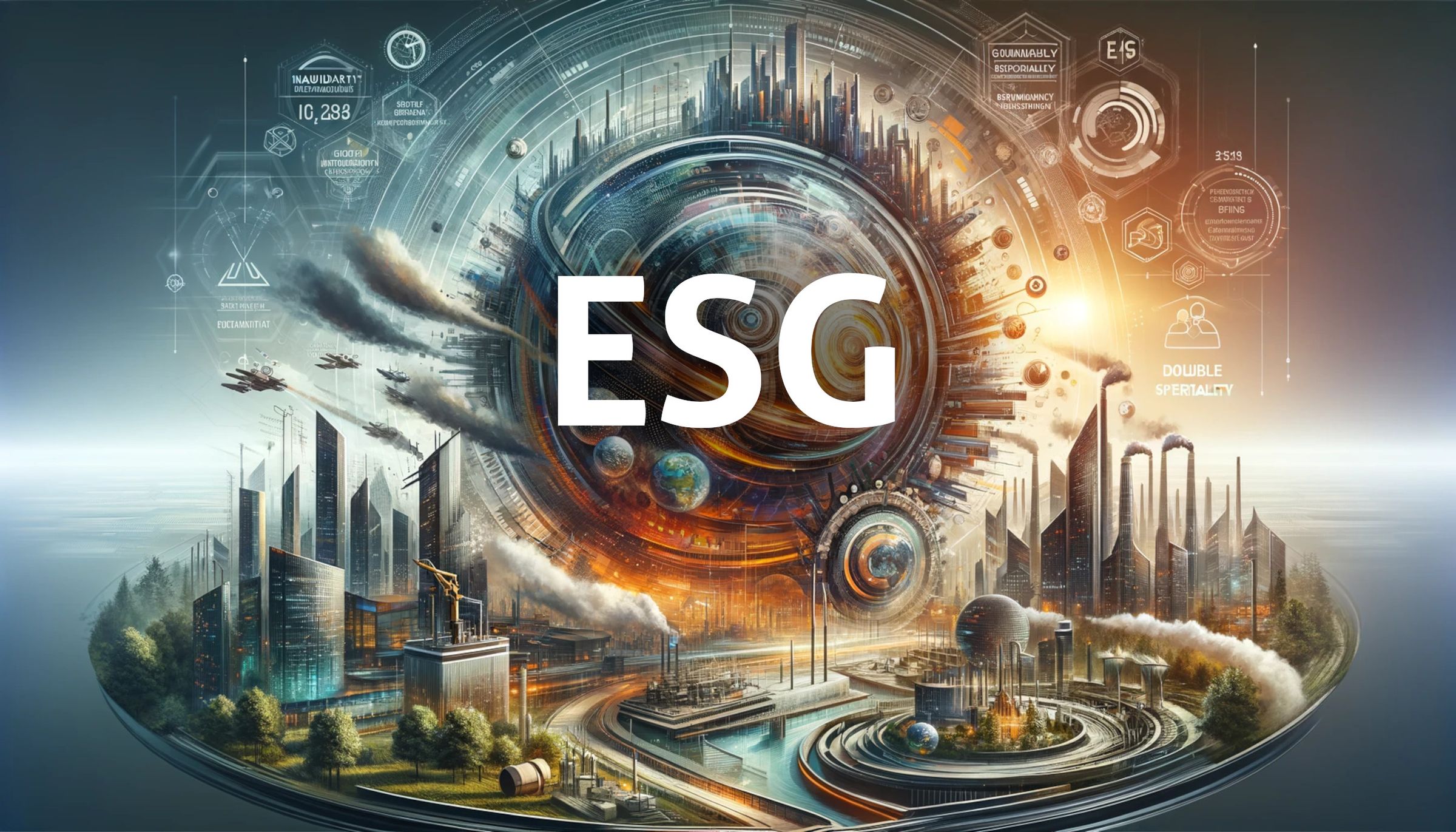In the corporate sphere, Environmental, Social, and Governance (ESG) standards are undergoing transformative changes, reshaping how businesses operate and report globally. These shifts, long overdue, are now rapidly unfolding, marking a pivotal moment in the history of corporate sustainability. A lot is going on, and there's a lot to be updated about, so here’s a helpful article putting some of the most important tectonic shifts on your radar.
From the European Union's groundbreaking mandatory ESG reporting requirements to the nuanced concept of 'double materiality', the landscape of ESG is evolving in profound ways. Additionally, the emergence of context-related goals and significant developments within key reporting frameworks like the ISSB are redefining the standards of corporate responsibility.
This article delves into these critical changes, served from the hot kitchen of Except's everyday sustainability consultancy practice, offering insights into the major implications and the new directions they are forging in the world of ESG. Let's go!
After reading, join the discussion on this article here on LinkedIn.
A quick history lesson: where did ESG come from?
Where better to start than with a quick history lesson on ESG? In the last decade, ESG has evolved into a global standard for companies to report and disclose their performance in Environmental, Social, and Governance aspects. ESG was first mentioned in 2006, in the context of financial investment policy guidelines from the United Nations.
Since then, in many respects, ESG has taken over the role of Corporate Social Responsibility (CSR) policies, which gained prominence in the late '90s and early 2000s. As often happens with public initiatives closely tied to marketing, the CSR trend waned, giving way to ESG and, in effect, became swallowed by it. While ESG started out as a concept that focuses on reporting and disclosing the role of investors, and financial investments, today ESG repackages many of CSR's concepts.
There's a critical distinction to note: historically, both CSR and ESG frameworks have been voluntary. This means companies have had the freedom to decide what and how they disclose information. The implications of this are worth pondering. See any issue there? You might.
Navigating the increasingly complex field of ESG

The overarching goal of ESG, and its many frameworks and acronyms, is to mitigate negative impacts on environmental and social targets. The majority of these efforts circulate around transparent and accurate reporting of the company’s impact and investments. Over time, ESG has become particularly framework-heavy. GRI, the oldest of these frameworks, launched in the '90s and forms the basis for many others including GRI, ISSB, TCFD, and the newly introduced ESRS framework by the EU. In practice, and an increasing point of broad criticism, is that ESG frequently devolves into a token gesture, more concerned with aligning with these reporting standards rather than driving genuine change.
Despite good intentions of organizations using their ESG strategy to minimize negative impacts, a significant portion of ESG practice is used by companies as a means to deflect criticism, while continuing their usual operations. Increased transparency through performance reporting is undoubtedly a valuable effort. The reality is that the reporting frameworks themselves can become a major distraction from implementing meaningful change. As sustainability consultants, we've observed numerous instances where a company's sustainability budget is largely consumed by creating ESG-compliant reports, with little left for actual transformative actions. It's not uncommon to see multinational companies with superficial policies, such as replacing plastic cups with paper ones, becoming ‘paper-free’ in the office, or purchasing carbon offset certificates from questionable sources. This highlights a critical issue: ESG frameworks, in their current form, do not necessarily facilitate real change. The realization of this is a major driver behind many of the changes in the ESG landscape we are seeing before us today.
An essential aspect to understand this is the widespread misconception equating ESG programs with a company's sustainability strategy. This is a significant misunderstanding. A sustainability strategy is fundamentally distinct from an ESG program, and the lack of clarity between the two does a disservice to both. The difference will be explored more in the following sections, and is a main reason why many ESG strategies have little effect beyond window dressing.
Upheaval in the foundations of ESG standards
We already mentioned some of the reporting frameworks, such as the GRI and ISSB. Be warned, a whole bunch more acronyms are about to be thrown your way. If you are not familiar with these, don’t fret, we will be doing real talk soon after this section. Knowing a bit about these frameworks is material to understand ESG and how it is undergoing a major upheaval.
ISSB and SASB merged
The International Sustainability Standards Board (ISSB), a major player in the ESG reporting framework, has recently been the focus of discussions in the sustainability community. Primarily oriented towards investor-focused reporting, ISSB contrasts with the Global Reporting Initiative (GRI), which targets a broader stakeholder audience. The ISSB was formed under the International Financial Reporting Standards (IFRS) Foundation, which subsequently merged a bunch of other standard-building foundations, including the CDSB and VRF, a move that aims to consolidate sustainability reporting standards under a single, globally recognized framework. This goal is somewhat questionable, seeing that the vast majority of organizations around the world do not use ISSB but the GRI to report (GRI estimates over 78%), and ISSB has focused on investment activities primarily, but ok.
Another significant development in this arena is the integration of another large framework, the Sustainability Accounting Standards Board (SASB), into the ISSB. These integrations have not been without controversy. Concerns have been raised by major organizations about the proposed changes to the SASB sustainability standards as well as the transparency and governance of this new board. These concerns primarily focus on the potential dilution of the robustness and specificity that these various standards offered, especially in industry-specific contexts. That said, grumbling and groaning in the world of ESG standards is par for the course, but we’re not done yet.
TCFD also merged with ISSB
Simultaneously, the Task Force on Climate-Related Financial Disclosures (TCFD), known for its detailed standards on carbon-related financial reporting, has transitioned its responsibilities to the ISSB as well. This transfer is significant, as it represents a consolidation of a major climate-related financial reporting standard under the ISSB's purview. The integration of TCFD standards into the ISSB framework is also being closely watched by stakeholders to ensure that the rigor and focus of TCFD are maintained. All these ‘mergers’ in the last few years are increasing the scrutiny of how the IFRS and ISSB are actually governed. And still there’s more shaky ground in this part of ESG land.
SBTi under heavy fire
The Science Based Targets initiative (SBTi) started in 2015, with the goal of providing a planet-wide goal trajectory for carbon emissions. This means, that the SBTi helps to set a goal that makes clear how much a company can emit, and how much it needs to reduce, to do its share according to this survival boundary. This boundary, for example, could be the Paris climate accord (remember, the 1.5C thing). Setting a carbon goal for a company in relation to what is actually needed for humanity to survive seems pretty relevant. We’ll be getting back to the importance of these ‘science based targets’ also called 'triple materiality' down below. Until recently, SBTi was a beacon of hope and progression in ESG land. However, the criticism has been relentless, accusing SBTi of bowing to industry pressure beyond acceptable levels. Critics include the German NewClimate Institute, having raised concerns about the stringency and accuracy of SBTi’s ratings, describing them as “highly contentious or inaccurate.”
These developments highlight the dynamic nature of ESG reporting standards and the ongoing debates surrounding their evolution. Merging a pile of competing standards can lead to many good things. It will also open up the consolidated frameworks to increasing lobbying pressure. As the ISSB moves forward with its mandate to standardize and streamline sustainability reporting, the feedback and concerns from various stakeholders will be crucial in shaping a framework that is both comprehensive and effective in addressing the complex dimensions of sustainability. Meanwhile, all this messiness, and often intransparent mergers and conflations, have led some experts to declare ESG as a whole dead in the water. One of these voices is Stern University finance professor Aswath Damodaran who declared ESG dead in the water in the Financial times in his article “RIP ESG”. Not good. But wait, there’s more to come.
Voluntary Carbon Market Disasters
Another area closely linked to ESG strategies, the voluntary carbon market (VCM), has recently come under significant criticism. Credits from the VCM, utilized by companies to offset their carbon emissions, are facing challenges regarding their effectiveness and integrity. A striking example surfaced in early 2023 when The Guardian reported that Verra, a leading VCM certification agency, certified over 94% of carbon offsets that were essentially ineffective. This revelation has been a major setback for the VCM industry. At the same time, carbon credits are under fire for being ineffective at distributing the invested money into actual projects, with most of it getting lost at middlemen, as the Wall Street Journal reports.
Criticism from the sustainability community towards the VCM has always been stern, viewing them as a workaround for responsibilities that should not be bypassed. In our sustainability consulting work, we have always considered buying carbon credits a last-resort option, advocating for direct reduction and compensation actions. The recent disclosures underscore our stance, highlighting the inherent risks for companies that rely solely on offsets for their impact mitigation.
That leaves both the reporting frameworks as well as one of the major tools of ESG under heavy fire, and very careful considerations must be placed by companies that value their risk management and future forecasting, as well as those wanting value from their sustainability investments and ESG trajectories.
The earth slide of the ESRS standards
The European Union has been closely monitoring these developments in the ESG sphere and has drawn similar conclusions. The realization that voluntary ESG frameworks lack the teeth for effective enforcement has led to the introduction of the Corporate Sustainability Reporting Directive (CSRD) and the European Sustainability Reporting Standards (ESRS), which went into effect in this quarter. (This is so new, Wikipedia only has the German version of the ESRS page up yet. Aaah, Germany!)
What the CSRD says is that companies above a certain size will be required to report on certain aspects, in a fixed manner, using the ESRS. The ESRS are built in alignment with the GRI standards. Because the ESRS becomes mandatory and fixed, this will forever change the nature of ESG reporting.
This is not an impact for the EU alone, as it will ripple through the world's supply chains towards the farthest corners of the earth. No matter where a company is based from, be it Argentina, Vietnam, or the UK, if a substantial amount of products and/or services are sold within the EU, these directives apply. Similarly for European based companies that source significant resources from outside the EU.
As you see, this impacts the global landscape, and not just the EU. Meanwhile, the EU isn't done with this initial policy introduction. This is the start of the ESRS roadmap that increases the reporting requirements significantly over time. Starting out mild with some basics and small carbon footprint items, the aspects on which to report on are expanding in breadth as well as in scope per item as time goes by.
This is a critical juncture we've been advising our clients about for years: the shift from voluntary to mandatory ESG data collection and reporting, now dictated by governmental terms. For companies not yet involved with the ESG frameworks, this will now require them to do so, and we continue to advise to be proactive about this, to be able to reap the benefits of this approach towards your bottom line rather than it just being a cost item to comply with.
The ESRS's double materiality bombshell
While making the reporting mandatory instead of voluntary is a major shift in ESG landscape, the ESRS has another earthquake up its sleeve. The ESRS standards will be introducing mandatory 'double materiality' to its reporting framework. Up until now, frameworks like GRI, TCFD, and ISSB have been working with 'single materiality'. In the case of the ISSB, this means focusing only on how market changes in sustainability affect a company’s financial health. The GRI solves this differently through a stakeholder involvement process to determine what matters and not, which, in many cases, results in reporting on only superficial things.
For ESG novices, it might come as a surprise that some of these frameworks have only been concerned with how issues like climate change affect a company's wallet, rather than examining how the company affects climate change. It's like realizing your umbrella has been designed to only keep rain off your wallet, and not your head. Strange things indeed, and so thought the EU.
Cue the EU's intervention in the ESRS with 'double materiality'. It’s a two way street now: companies must report not just on how sustainability topics impact them, but also how they impact these sustainability issues. For organizations already in the ESG lane, this means a significant detour in both what and how they report. Initially, the EU's roadmap for the ESRS suggests this will start off as a gentle jog, but over time, it's set to become a full-blown marathon with increasingly stringent and tighter requirements.
The push for context related goals or 'triple materiality'

While the ESRS is a great first step towards making the ESG frameworks have some kind of teeth and impact, to those in the know, it doesn't go far enough. While 'double materiality' is a valuable step forward to make the reporting be about something substantial, they are still devoid of the actual context that we all care about when talking about sustainability. This is because even in double materiality, the goals that are set by each company are not necessarily related to… anything at all. They are only related to whatever the company decides to set their goal at. For example, the goal to try to achieve carbon neutrality in 2030, 2050 or 2070? Those are three majorly different ambitions. Trying to become carbon neutral in 2030 is a steep and challenging goal, while doing the same by 2070 is appallingly slow and irresponsible. As you can see, where a goal is set makes all the difference. And that goes for all targets, including things like waste, water, biodiversity, social targets, and so forth. If there is no context given, then setting a goal is a pretty arbitrary affair which allows organizations to get away with the weakest of goals and measures.
Originally, the Science Based Targets initiative (SBTi) was created to foster this kind of alignment, albeit focused only on carbon and climate change aspects. However, the SBTi has recently faced criticism for allegedly straying from its science-based roots and weakening its standards. This setback has left a gap in the push for robust, contextually anchored ESG goals. Stepping into this void is the United Nations Research Institute for Social Development (UNRISD), which has been advocating for their more rigorous approach to sustainability goal setting through its “Authentic Sustainability Assessment” (ASA) framework.
The growing acceptance of these standards indicates a shift in the ESG landscape towards goals that are not only meaningful but also explicitly linked to the sustainability challenges we face globally. While carbon emissions is the spearhead topic here, other pressing planetary boundaries such as biodiversity loss, are bound to start poking around in this space as well. We foresee the increased adoption of standards of triple materiality, which will further push the ESG landscape to become meaningful, and tied to the thing it actually purports to be for. This still does require a systemic analysis and framework to start taking into account the other concerns besides carbon, and that's where sustainability strategy frameworks may have more answers. So let's see what's going on there?
Sustainability strategy growing over ESG strategy

In the world of ESG, the terms 'sustainability strategy' and 'ESG strategy' are often used interchangeably, but they represent significantly different concepts. An ESG strategy typically revolves around adhering to one of the standard frameworks (like GRI), establishing data gathering and reporting mechanisms, setting goals, and then publishing a disclosure report. On the other hand, a sustainability strategy involves developing a long-term plan for transforming a company into a contributor to a sustainable society. This kind of strategy goes beyond mere reporting; it is about understanding how the world is moving towards sustainability and how a company can both fit into and contribute to this transition.
A genuine sustainability strategy often inherently includes the concept of 'triple materiality' because it is fundamentally concerned with the company’s impact on the world and vice versa. This approach leads to a transition roadmap that becomes central to the company’s overall strategy, not just a component of a sustainability department. In our experience, a company truly committed to sustainability does not have a sustainability department at all; sustainability becomes a foundational principle guiding the entire organization. Therefore, a sustainability strategy is usually the starting point for a new, comprehensive approach for the whole company, integrating sustainability into all facets of operation, from market strategies to finance, and operations.
More and more companies are realizing that starting with an ESG strategy, particularly within the confines of a sustainability department, can lead to escalating costs with limited corporate benefit. This is often due to a misunderstanding of sustainability, seen as an add-on rather than as a core business strategy. When sustainability is embraced as an all-encompassing strategy, the real benefits, both short-term and long-term, begin to emerge. But this requires building a solid sustainability strategy first; approaching it the other way around is likely to be both challenging and ineffective.
Despite the proliferation of ESG frameworks and the considerable resources available to support their implementation, driven in part by large consultancies and the big four accounting firms, there is a notable gap in services for developing comprehensive sustainability strategies. These accountancy-based consultancies typically focus on ESG due to its alignment with their core competencies in data gathering, verification, and reporting. Developing a sustainability strategy, however, requires a fundamentally different set of skills and expertise. Which, of course, is not convenient for the accountancy firms, which means more often than not, this part is simply left off the table altogether. There are frameworks available to aid in building a sustainability strategy, though they are less well-known than ESG frameworks, because they do not have these behemoths of corporate reporting pushing them into the market by force. To streamline our sustainability strategy advisory, we developed Symbiosis in Development (SiD), an open-source framework designed to guide building an effective sustainability strategy using systems analysis, transition management, co-creation, and design thinking. SiD is celebrating about two decades actively used in the field, and is slowly gaining adoption worldwide as an overarching framework that brings together transition and change management with, where necessary and valuable, ESG.
Today’s ESG financial investment analysis

Let’s have a quick look back at ESG’s origins. Remember, ESG’s original purpose was to be able to evaluate a company for investment decisions purposes. The introduction of 'double materiality' and the emerging concept of 'triple materiality' are steps toward transforming ESG reporting into a more genuine risk analysis instrument. Yet, we are still far from this ideal.
Presently, relying on a company's ESG report based on frameworks like GRI or ISSB for investment decisions is like navigating a maze blindfolded. Without context-based scientific analysis or goals, such evaluations are guesswork at best, more akin to hocus pocus than risk analysis. These reports, as they stand, offer only a fractional and sometimes distorted view of a company's true sustainability risks and opportunities.
With the integration of 'triple materiality', there's a glimmer of hope. Especially when universal standards are enforced that encompass all major societal challenges, all planetary and social boundaries to start with. This approach would better reflect a company's long-term viability in relation to global trends. But let's not get ahead of ourselves; it's still a long road to reach a point where ESG reports provide a reliable tool for financial investment evaluation without significant additional effort.
From an investment perspective, the horizon looks promising, but we're still navigating through murky waters. A GRI-compliant ESG report today offers only a fragmented view of actual risk and opportunity insights. And yes, it's worth noting that these reports have their vulnerabilities, open to manipulation and selective representation.
The more immediate and accurate approach lies in conducting an integrated systemic analysis of a company, and building a sustainability strategy roadmap from this. This means delving into its systemic connectivity with society, examining supply chains, market trends, and stakeholder interests, including environmental impacts. Such an analysis forms the bedrock of a robust sustainability strategy, and is enabled by systems analysis tools such as SiD, but it’s something currently not encapsulated within the typical ESG strategy framework, and a long way off.
Conclusion
The developments outlined in this article reflect a dynamic and rapidly evolving ESG landscape. The changes are not merely about the content of the ESG frameworks but represent a fundamental shift in their purpose and policy context. Importantly, more companies are recognizing that an ESG strategy on its own is insufficient. ESG reporting frameworks, while valuable, do not necessarily facilitate the development of a long-term sustainability strategy.
The need for a comprehensive sustainability strategy, as a foundation for ESG and leading to a transformative roadmap, is increasingly seen as critical. Companies that embark on this journey can expect to reap long-term benefits from their commitment to sustainable impact. Those that do not will likely face escalating costs due to new regulatory guidelines, reporting, and disclosure requirements, without significant benefits to their bottom line.
Thoughts? Discuss with us
Discuss this article with us on LinkedIn.
Dec. 20, 2023





